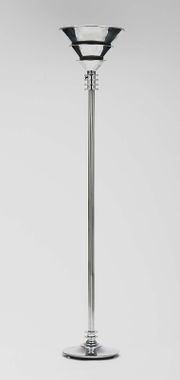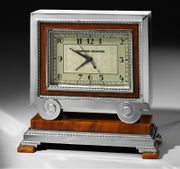Difference between revisions of "Chromium"
| (11 intermediate revisions by 3 users not shown) | |||
| Line 1: | Line 1: | ||
| + | [[File:Chromeplated lamp1985672.jpg|thumb|Chrome-plated lamp<br>MFA# 1985.672]] | ||
== Description == | == Description == | ||
| − | Hard, brittle metallic element that takes a high polish. Chromium was discovered as an element in 1797 by Louis-Nicholas Vauquelin of France. It has an abundance of 122 parts per million in the earth's crust. It is primarily found as the ore chromite. Chromium is added to steel alloys to increase hardness and corrosion resistance (see [[stainless steel]]). It is also used for plating other metals since it readily forms a thin oxide surface layer that resists corrosion (see [[chrome plate]]). Chromium salts are used as pigments in paint and glass, as mordants for dyeing textiles, for tanning leather and as wood preservatives. Some chromium salts, such as chromium acetate, exhibit an alexandrite effect where | + | Hard, brittle metallic element that takes a high polish. Chromium was discovered as an element in 1797 by Louis-Nicholas Vauquelin of France. It has an abundance of 122 parts per million in the earth's crust. It is primarily found as the ore chromite. Chromium is added to steel alloys to increase hardness and corrosion resistance (see [[stainless steel]]). It is also used for plating other metals since it readily forms a thin oxide surface layer that resists corrosion (see [[chrome plate]]). Chromium salts are used as pigments in paint and glass, as mordants for dyeing textiles, for tanning leather and as wood preservatives. Some chromium salts, such as chromium acetate, exhibit an alexandrite effect where they appear red in concentrated solutions and green in dilute solutions. |
| + | Chromium is on the ILFI [[Red list of Materials|Red list]] of building materials. | ||
== Synonyms and Related Terms == | == Synonyms and Related Terms == | ||
Cr; Chroom (Ned.); chrome (Fr.); Chrom (Deut.); cromo (It., Esp.); crómio (Port.); Krom (Sven.) | Cr; Chroom (Ned.); chrome (Fr.); Chrom (Deut.); cromo (It., Esp.); crómio (Port.); Krom (Sven.) | ||
| + | [[File:Mantelclock 2008.279.jpg|thumb|Mantel clock<br>MFA# 2008.279]] | ||
| + | ==Risks == | ||
| − | == | + | * Toxic by inhalation of dust. Can cause breathing problems and lung cancer. |
| + | * Skin contact may cause irritation and skin ulcers. | ||
| + | * Chromium salts are toxic by ingestion. Can cause stomach tumors | ||
| + | * Carcinogenic. | ||
| + | * ThermoFisher: [https://www.fishersci.com/store/msds?partNumber=AC196610250&productDescription=CHROMIUM%28VI%29+OXIDE%2C+99%2B%25+25GR&vendorId=VN00032119&countryCode=US&language=en SDS] | ||
| − | + | == Physical and Chemical Properties == | |
| − | + | * Soluble in alkalis and acids except for nitric. Insoluble in water. | |
| + | * Body-centered cubic structure. | ||
| + | * [[diphenylcarbazide|Diphenylcarbazide]] solution is used for the colorimetric detection of chromium in metals, tanned leathers and pigments (Odegaard et al 2000) | ||
{| class="wikitable" | {| class="wikitable" | ||
| Line 25: | Line 35: | ||
|- | |- | ||
! scope="row"| Melting Point | ! scope="row"| Melting Point | ||
| − | | 1903 | + | | 1903 C |
|- | |- | ||
! scope="row"| Density | ! scope="row"| Density | ||
| − | | 7.14 | + | | 7.14 g/ml |
|- | |- | ||
! scope="row"| Molecular Weight | ! scope="row"| Molecular Weight | ||
| Line 34: | Line 44: | ||
|- | |- | ||
! scope="row"| Boiling Point | ! scope="row"| Boiling Point | ||
| − | | 2642 | + | | 2642 C |
|} | |} | ||
| − | == | + | == Resources and Citations == |
| − | |||
| − | |||
| − | |||
| − | |||
| − | |||
| − | |||
| − | |||
| − | |||
| − | |||
| − | |||
| + | * N.Odegaard, S.Carroll, W.Zimmt, ''Material Characterization Tests for Objects of Art and Archaeology'' Archetype Publications, London, 2000, p.44. | ||
| + | * Web Elements: [http://www.webelements.com/webelements/elements/text/Cr/key.html Website] | ||
* ''Van Nostrand's Scientific Encyclopedia'', Douglas M. Considine (ed.), Van Nostrand Reinhold, New York, 1976 | * ''Van Nostrand's Scientific Encyclopedia'', Douglas M. Considine (ed.), Van Nostrand Reinhold, New York, 1976 | ||
| − | |||
* Random House, ''Webster's Encyclopedic Unabridged Dictionary of the English Language'', Grammercy Book, New York, 1997 | * Random House, ''Webster's Encyclopedic Unabridged Dictionary of the English Language'', Grammercy Book, New York, 1997 | ||
| − | |||
* ''The American Heritage Dictionary'' or ''Encarta'', via Microsoft Bookshelf 98, Microsoft Corp., 1998 | * ''The American Heritage Dictionary'' or ''Encarta'', via Microsoft Bookshelf 98, Microsoft Corp., 1998 | ||
| − | |||
| − | |||
| − | |||
* Richard S. Lewis, ''Hawley's Condensed Chemical Dictionary'', Van Nostrand Reinhold, New York, 10th ed., 1993 | * Richard S. Lewis, ''Hawley's Condensed Chemical Dictionary'', Van Nostrand Reinhold, New York, 10th ed., 1993 | ||
| − | |||
* ''The Merck Index'', Martha Windholz (ed.), Merck Research Labs, Rahway NJ, 10th edition, 1983 Comment: entry 2288 | * ''The Merck Index'', Martha Windholz (ed.), Merck Research Labs, Rahway NJ, 10th edition, 1983 Comment: entry 2288 | ||
| − | |||
* G.S.Brady, ''Materials Handbook'', McGraw-Hill Book Co., New York, 1971 Comment: p. 193 | * G.S.Brady, ''Materials Handbook'', McGraw-Hill Book Co., New York, 1971 Comment: p. 193 | ||
| − | |||
* ''Dictionary of Building Preservation'', Ward Bucher, ed., John Wiley & Sons, Inc., New York City, 1996 | * ''Dictionary of Building Preservation'', Ward Bucher, ed., John Wiley & Sons, Inc., New York City, 1996 | ||
| − | |||
* Hermann Kuhn, ''Conservation and Restoration of Works of Art and Antiquities'', Butterworths, London, 1986 | * Hermann Kuhn, ''Conservation and Restoration of Works of Art and Antiquities'', Butterworths, London, 1986 | ||
| − | |||
* Tom Rowland, Noel Riley, ''A-Z Guide to Cleaning, Conserving and Repairing Antiques'', Constable and Co., Ltd., London, 1981 | * Tom Rowland, Noel Riley, ''A-Z Guide to Cleaning, Conserving and Repairing Antiques'', Constable and Co., Ltd., London, 1981 | ||
| − | |||
* Michael McCann, ''Artist Beware'', Watson-Guptill Publications, New York City, 1979 | * Michael McCann, ''Artist Beware'', Watson-Guptill Publications, New York City, 1979 | ||
Latest revision as of 13:47, 3 November 2023
Description
Hard, brittle metallic element that takes a high polish. Chromium was discovered as an element in 1797 by Louis-Nicholas Vauquelin of France. It has an abundance of 122 parts per million in the earth's crust. It is primarily found as the ore chromite. Chromium is added to steel alloys to increase hardness and corrosion resistance (see Stainless steel). It is also used for plating other metals since it readily forms a thin oxide surface layer that resists corrosion (see Chrome plate). Chromium salts are used as pigments in paint and glass, as mordants for dyeing textiles, for tanning leather and as wood preservatives. Some chromium salts, such as chromium acetate, exhibit an alexandrite effect where they appear red in concentrated solutions and green in dilute solutions.
Chromium is on the ILFI Red list of building materials.
Synonyms and Related Terms
Cr; Chroom (Ned.); chrome (Fr.); Chrom (Deut.); cromo (It., Esp.); crómio (Port.); Krom (Sven.)
Risks
- Toxic by inhalation of dust. Can cause breathing problems and lung cancer.
- Skin contact may cause irritation and skin ulcers.
- Chromium salts are toxic by ingestion. Can cause stomach tumors
- Carcinogenic.
- ThermoFisher: SDS
Physical and Chemical Properties
- Soluble in alkalis and acids except for nitric. Insoluble in water.
- Body-centered cubic structure.
- Diphenylcarbazide solution is used for the colorimetric detection of chromium in metals, tanned leathers and pigments (Odegaard et al 2000)
| Composition | Cr (atomic no. 24) |
|---|---|
| CAS | 7440-47-3 |
| Mohs Hardness | 9.0 |
| Melting Point | 1903 C |
| Density | 7.14 g/ml |
| Molecular Weight | atomic wt = 51.996 |
| Boiling Point | 2642 C |
Resources and Citations
- N.Odegaard, S.Carroll, W.Zimmt, Material Characterization Tests for Objects of Art and Archaeology Archetype Publications, London, 2000, p.44.
- Web Elements: Website
- Van Nostrand's Scientific Encyclopedia, Douglas M. Considine (ed.), Van Nostrand Reinhold, New York, 1976
- Random House, Webster's Encyclopedic Unabridged Dictionary of the English Language, Grammercy Book, New York, 1997
- The American Heritage Dictionary or Encarta, via Microsoft Bookshelf 98, Microsoft Corp., 1998
- Richard S. Lewis, Hawley's Condensed Chemical Dictionary, Van Nostrand Reinhold, New York, 10th ed., 1993
- The Merck Index, Martha Windholz (ed.), Merck Research Labs, Rahway NJ, 10th edition, 1983 Comment: entry 2288
- G.S.Brady, Materials Handbook, McGraw-Hill Book Co., New York, 1971 Comment: p. 193
- Dictionary of Building Preservation, Ward Bucher, ed., John Wiley & Sons, Inc., New York City, 1996
- Hermann Kuhn, Conservation and Restoration of Works of Art and Antiquities, Butterworths, London, 1986
- Tom Rowland, Noel Riley, A-Z Guide to Cleaning, Conserving and Repairing Antiques, Constable and Co., Ltd., London, 1981
- Michael McCann, Artist Beware, Watson-Guptill Publications, New York City, 1979

